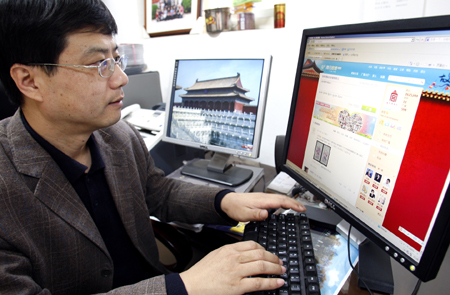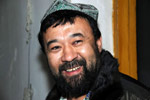Society
New space for ancient place
Updated: 2011-02-15 07:52
By Liu Zhihua (China Daily)
|
 Feng Nai'en, one of three operators of "The Palace Museum" micro blog, is also director of the Administrative Office of the Palace Museum. Photos by Zhang Wei / China Daily |
The Palace Museum is running a popular micro blog that answers questions about its building and collection. Liu Zhihua reports.
"Gu Gu, today I slept until I felt a little giddy. I want to know, could the emperors of the Qing Dynasty (1644-1911) sleep as long as they liked?" This is one of the many questions on the Tencent micro blog "The Palace Museum" from one its more than 1.6 million followers.
"No, they were very diligent. They woke up to work very early," "The Palace Museum" answers, adding a sweat emoticon.
From 8:30 am to midnight, "The Palace Museum" answers questions in a professional but lighthearted manner.
The individual who answers the questions is often referred to in messages as "Gu Gu", "Brother Gu", or "Brother Gong" by followers, in a reference to the Forbidden City's Chinese name, Gugong.
"We use micro blogs because we are aware of their power for direct communication," says Feng Nai'en, one of three operators of "The Palace Museum" and director of the Administrative Office of the Palace Museum.
"But we didn't expect it would be so popular."
Registered on Jan 1, the micro blog's first two tweets said, "Hello", while the third said Shufang Yard, the residence of a Qing Dynasty princess in a nationally acclaimed television series, was where the royal family enjoyed operas.
The tweet was instantly re-tweeted and commented on by 45 people. In an hour, the number of followers reached 10,000. Five hours later, the number reached 100,000.
People started asking such questions as, "Why are visitors not allowed to go into some places in the palace?" and, "Are all animals not allowed into the palace? What about guide dogs?" and, "Are there really ghosts in the palace at night?"
"What makes the museum lively and special is not only its buildings and collection, but also the stories and anecdotes behind those collections and buildings," Feng says
"We want to offer knowledge about the museum that people are interested in but is out of their reach."
|
 The Hall of Preserving Harmony in the Forbidden City. |
Feng has two colleagues working with him on the program. One is Chang Lingxing, a public relations officer in his late 20s; the other is 30-something Da Weijia, chief editor of the museum's website.
"This is not the first time we have used digital technology to promote the museum. As early as 2007, the museum created a group on (social network platform) Douban," Da says.
"Now we want to make the most of micro-blogging, which is fast and effective."
The three work in shifts to post massages, in addition to doing their regular work.
They also tweet about the museum's history, the collections, the buildings and e-shop, and post information about exhibitions, forums, research achievements, and activities. Most importantly, they try their best to make the content funny and knowledge-rich.
Da once read that the ears of the palace's lion statues were down because in the past it was believed the emperor was the son of heaven, so lions were afraid of him and their ears would go down to show their obedience.
Da wondered if it was true.
She examined all the lion statues, and found that not all the statues conformed to what the book said. In front of the Hall of Supreme Harmony, the largest hall within the immense Forbidden City palace complex, a pair of lions has alert ears.
Da posted photos she took on the micro blog and was praised by followers.
"The Palace Museum is not just a mysterious building with four closed walls, but an organization with stories from the past and present," Feng says.
"We hope our efforts will help people know more about the museum, no matter whether they visit the museum in the real world or not."
Specials

Spring Festival
The Spring Festival is the most important traditional festival for family reunions.

Top 10
A summary of the major events both inside and outside China.

A role model
Alimjan Halik had been selected as the "Cyberspace Personality Who Moved the Hearts of the Chinese in 2010".